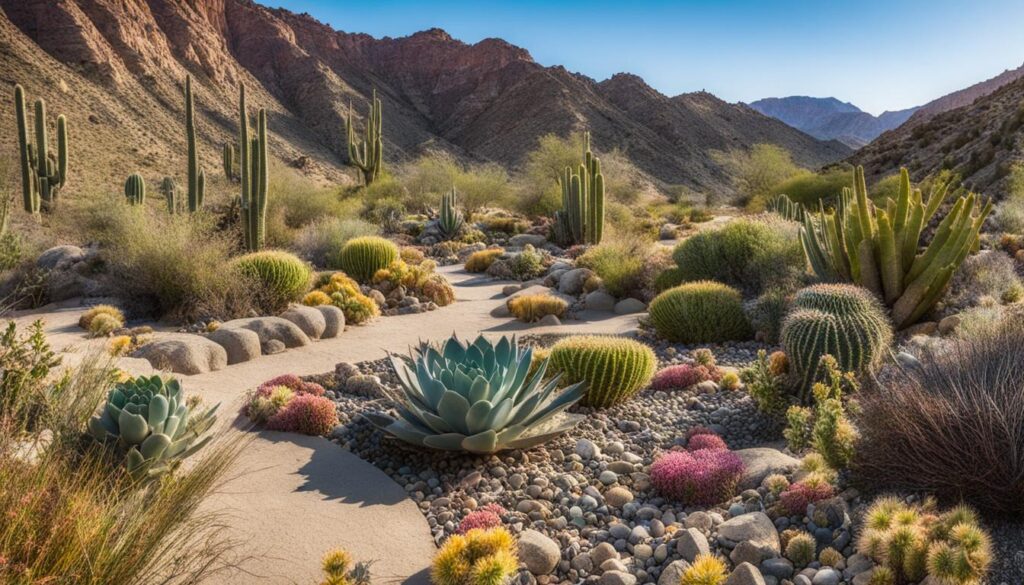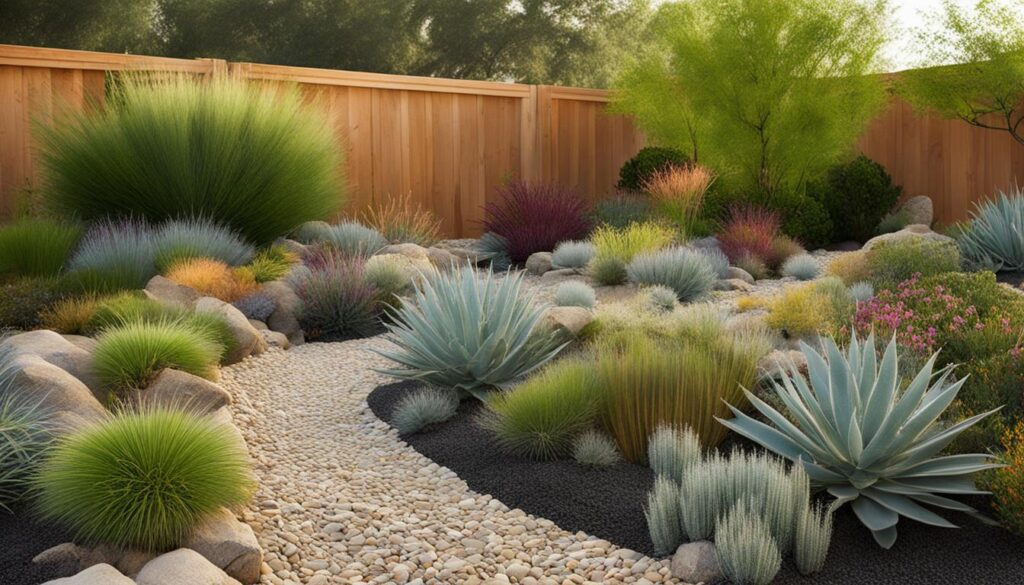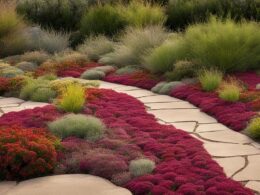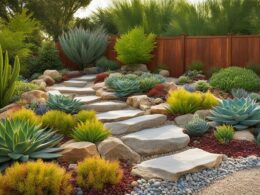Xeriscaping is a sustainable landscaping method that conserves water and promotes the use of drought-resistant plants. It is especially beneficial in arid regions like Salt Lake City and Denver. By understanding the principles of xeriscaping and implementing native and drought-resistant plants, beginners can create eco-friendly and low-maintenance landscapes that preserve water, save money, and support local wildlife.
Key Takeaways:
- Native xeriscape ideas help beginners create eco-friendly landscapes.
- Xeriscaping conserves water and supports local wildlife.
- Drought-resistant plants reduce maintenance requirements.
- Xeriscaping promotes water conservation and cost-effectiveness.
- Start your xeriscaping journey today for a greener and more sustainable future.
The Benefits of Xeriscaping for Water Conservation
Xeriscaping is a landscaping method that offers numerous benefits, especially when it comes to water conservation. By implementing xeriscaping techniques, homeowners can significantly reduce their water consumption and contribute to a more sustainable future.
A xeriscape design can lead to a remarkable reduction in water usage. In arid regions like Salt Lake City and Denver, adopting xeriscaping practices can result in water savings of up to 70-80% compared to traditional lawns and gardens. This is a significant conservation effort that not only saves water but also helps alleviate the strain on local water supplies, particularly during the hot and dry summer months.
Implementing xeriscaping methods not only benefits the environment but also brings financial advantages. By reducing water usage, homeowners can expect lower water bills. Additionally, the low-maintenance nature of xeriscaping can lead to reduced maintenance costs over time. With fewer resources required for watering and upkeep, xeriscaping offers a cost-effective solution for sustainable landscaping.
Xeriscaping Benefits for Water Conservation
“Xeriscaping can reduce water usage by up to 70-80% compared to traditional lawns and gardens.”
It is worth noting that the benefits of xeriscaping extend beyond water conservation. By embracing xeriscaping, homeowners can create landscapes that require less maintenance. Traditional gardens often demand significant time and effort in terms of weeding, watering, and mowing. In contrast, xeriscapes utilize drought-resistant plants that require less maintenance once established. This allows homeowners to spend more time enjoying their beautiful landscapes and less time on upkeep.
Summarizing, xeriscaping is a sustainable landscaping method that not only conserves water but also offers financial savings and reduced maintenance needs. By implementing xeriscaping techniques, homeowners can contribute to water conservation efforts and create eco-friendly outdoor spaces. Start your xeriscaping journey today and be a part of a greener and more sustainable future.
| Benefits of Xeriscaping | Water Conservation |
|---|---|
| Significantly reduces water consumption | Up to 70-80% compared to traditional lawns and gardens |
| Alleviates strain on local water supplies | Especially during hot and dry months |
| Lower water bills | Financial savings from reduced water usage |
| Reduced maintenance needs | Less time and effort spent on upkeep |
Low Maintenance Landscaping with Xeriscaping
One of the main reasons why homeowners choose xeriscaping is its low maintenance requirements. Traditional gardens often demand significant time and effort for tasks like weeding, watering, and mowing. However, with xeriscaping, you can create a beautiful and vibrant landscape that requires less maintenance once established. By incorporating drought-resistant plants and efficient irrigation methods, you can minimize the time and effort spent on upkeep, allowing you to enjoy your outdoor space to the fullest.
When it comes to xeriscaping, the key is to select plants that are well-adapted to your local climate and soil conditions. These plants are naturally more resistant to drought and require less water, making them ideal for low maintenance landscaping. By choosing the right plants, you can reduce the need for frequent watering, fertilizing, and pruning. Additionally, the use of organic mulch helps retain soil moisture, suppresses weed growth, and regulates soil temperature, further reducing the need for excessive maintenance.
Xeriscaping also minimizes the need for mowing and other time-consuming lawn care tasks. Traditional lawns often require regular mowing to maintain their appearance, but with xeriscaping, the focus is on creating a natural, sustainable landscape that embraces the beauty of native plants. By reducing the size of your lawn or eliminating it altogether, you can significantly decrease the time and effort spent on mowing and instead devote that time to other activities you enjoy.
With xeriscaping, you can have a stunning, low maintenance landscape that not only saves you time and effort but also contributes to water conservation efforts. By choosing the right plants, incorporating efficient irrigation methods, and minimizing lawn areas, you can create an eco-friendly and visually appealing outdoor space that requires less maintenance and provides long-lasting beauty.
Benefits of Low Maintenance Landscaping
• Saves Time: By reducing the need for frequent maintenance tasks like watering, mowing, and pruning, xeriscaping frees up your time to focus on other activities and enjoy your outdoor space.
• Saves Money: With lower maintenance requirements, xeriscaping helps reduce water bills, lawn care costs, and the need for expensive equipment and fertilizers.
• Supports the Environment: Xeriscaping conserves water, minimizes the use of harmful chemicals, and promotes biodiversity by providing a habitat for native wildlife and pollinators.
• Increases Property Value: A well-maintained xeriscape landscape can enhance curb appeal and increase the value of your property.
Low Maintenance Plants for Xeriscaping
| Plant Name | Plant Type | Water Requirements | Sun Exposure |
|---|---|---|---|
| Agave | Perennial | Low | Full Sun |
| Lavender | Perennial | Low to Medium | Full Sun |
| Sage | Perennial | Low | Full Sun |
| Yucca | Perennial | Low | Full Sun |
“Xeriscaping not only allows you to have a beautiful landscape without the high maintenance, but it also helps conserve water and supports a more sustainable future.”
Creating a Wildlife Habitat with Xeriscaping
Xeriscaped gardens are not only environmentally friendly but also play a vital role in creating habitats for local wildlife. By incorporating native plants into your xeriscape design, you provide shelter and food sources for important pollinators such as butterflies, bees, and birds. This promotes biodiversity and supports the balance of the local ecosystem.
The use of native plants in xeriscaping is key to attracting and sustaining wildlife in your garden. Native plants have evolved alongside local wildlife and are well-suited to the specific climate and soil conditions of the region. They provide familiar food sources and habitats for birds and insects, contributing to the overall health of the ecosystem.
When choosing native plants for your xeriscape, consider their ability to attract specific wildlife. Native flowers, for example, can attract butterflies and bees with their nectar-rich blooms. Berry-producing shrubs like serviceberries can provide food for birds throughout the year. By diversifying your plant selection, you create a thriving wildlife habitat in your own backyard.
In addition to native plants, incorporating other wildlife-friendly features into your xeriscape can further enhance its appeal to local fauna. Building birdhouses or installing birdbaths can provide additional nesting and drinking opportunities for birds. Providing a water source, such as a small pond or shallow dish, can attract various insects and amphibians.
By creating a wildlife habitat with xeriscaping, you not only contribute to the conservation of local species but also have the opportunity to observe and enjoy the beauty of nature in your own backyard.
Getting Started with Xeriscaping
To embark on your xeriscaping journey, it is essential to evaluate your landscape and make informed decisions regarding plant selection, soil improvement, and irrigation methods. By following these steps, you can create a thriving and sustainable xeriscape that conserves water and enhances the beauty of your outdoor space.
Evaluation
The first step in getting started with xeriscaping is to evaluate your landscape. Consider factors such as sunlight and shade patterns, soil type, drainage, and existing plant species. This evaluation will help you determine the best approach to xeriscaping for your specific landscape.
Take note of areas that receive full sun, partial shade, or full shade throughout the day. This information will guide your plant selection process and ensure that you choose the right plants for each area of your landscape.
| Factors to Evaluate | Considerations |
|---|---|
| Sunlight and Shade | Take note of areas that receive full sun, partial shade, or full shade throughout the day. |
| Soil Type | Determine the type of soil you have, whether it’s sandy, clayey, or loamy. This information will help you select plants that are well-suited to your soil conditions. |
| Drainage | Observe how water drains in different areas of your landscape. Identify any problem areas that may require additional drainage solutions. |
| Existing Plant Species | Take inventory of the plants currently growing in your landscape. Determine which plants are suitable for xeriscaping and which may need to be replaced. |
Plant Selection
Once you have evaluated your landscape, it’s time to choose the right plants for your xeriscape design. Native and drought-resistant plants are ideal choices as they are well-adapted to the local climate and require less water to thrive.
Consider incorporating a variety of plants to create a visually appealing landscape. Choose plants with different heights, textures, and colors to add interest and diversity to your xeriscape.
- Utah Serviceberry
- Red Yucca
- Western Sundancer Daisy
- Utah Juniper
- Penstemon
These native plants are well-suited to the Salt Lake City and Denver regions and will thrive in xeriscapes. Research the specific care requirements for each plant to ensure they receive the proper care and maintenance.
Soil Improvement
Improving the quality of your soil is essential for successful xeriscaping. Incorporating organic matter into the soil improves water retention and drainage, creating an optimal environment for your xeriscape plants.
“The addition of compost or well-rotted manure can greatly improve soil structure and nutrient content, leading to healthier plant growth.” – Gardening Expert
Amend your soil with compost, well-rotted manure, or other organic materials to enhance its fertility and water-holding capacity. This will reduce the need for frequent watering and improve the overall health of your xeriscape garden.
Consider the specific needs of your landscape, choose the right plants, and improve your soil to lay the foundation for a successful xeriscape. With proper evaluation, plant selection, and soil improvement, you can create a sustainable and visually stunning outdoor space that conserves water and supports local ecosystems. Get started with your xeriscaping project today!
Native Xeriscape Ideas for Salt Lake City and Denver
When it comes to creating a native xeriscape in Salt Lake City and Denver, there are numerous plant options that will thrive in the local climate and require less water. Incorporating these plants into your xeriscape design will not only result in a beautiful and visually appealing landscape but also contribute to water conservation efforts in these arid regions.
Drought-Resistant Plants for Salt Lake City
For Salt Lake City, consider incorporating the following native xeriscape plants:
- Utah Serviceberry (Amelanchier utahensis) – This deciduous shrub or small tree features delicate white flowers in the spring, followed by edible berries that attract birds.
- Red Yucca (Hesperaloe parviflora) – Known for its architectural structure and vibrant red or coral flowers, this plant is both drought-tolerant and deer-resistant.
- Western Sundancer Daisy (Hymenoxys acaulis) – This perennial plant produces bright yellow daisy-like flowers and thrives in hot and dry conditions.
Native Plants for Xeriscaping in Denver
If you’re in Denver, consider incorporating these native xeriscape plants into your landscape:
- Utah Juniper (Juniperus osteosperma) – A slow-growing evergreen tree that adds texture and visual interest to your xeriscape with its unique blue-green foliage.
- Penstemon – Denver is home to a variety of penstemon species, such as Penstemon strictus (Rocky Mountain Penstemon), which displays stunning purple-blue flowers and attracts pollinators.
By choosing these native plants for your xeriscape, you’re not only ensuring their survival in the local climate but also supporting the local wildlife by providing food and shelter for important pollinators.
| Plant | Climate | Water Needs |
|---|---|---|
| Utah Serviceberry | Salt Lake City | Low |
| Red Yucca | Salt Lake City | Low |
| Western Sundancer Daisy | Salt Lake City | Low |
| Utah Juniper | Denver | Low |
| Penstemon | Denver | Low |
Maintaining a Xeriscape Garden
Once you have established your xeriscape garden, it requires minimal maintenance compared to traditional landscapes. However, regular care is still necessary to keep your garden looking vibrant and healthy. By following a few simple tasks, you can ensure that your xeriscape garden remains beautiful and thriving.
One essential aspect of maintaining a xeriscape garden is pruning. Regular pruning helps control the growth of plants, promotes air circulation, and enhances their overall appearance. Remove any dead or damaged branches to encourage new growth and maintain the desired shape of your plants.
Another important maintenance task is fertilizing. Although xeriscape gardens generally require less fertilizer than traditional gardens, it’s still important to provide necessary nutrients to your plants. Use a slow-release organic fertilizer suitable for drought-resistant plants to promote healthy growth and vibrant colors.
Additionally, mulching is crucial for retaining soil moisture and suppressing weed growth in a xeriscape garden. Apply a layer of organic mulch around your plants, leaving a gap around the stem to prevent rot. Mulch not only conserves water by reducing evaporation but also helps regulate soil temperature and prevent soil erosion.
Table: Essential Maintenance Tasks for a Xeriscape Garden
| Maintenance Tasks | Frequency |
|---|---|
| Pruning | Twice a year (spring and fall) |
| Fertilizing | Once a year (early spring) |
| Mulching | Annually or as needed |
By incorporating these maintenance tasks into your routine, you can ensure that your xeriscape garden remains healthy and visually appealing throughout the year. Remember to monitor your plants for any signs of pests or diseases and take appropriate action if needed. With regular care, your xeriscape garden will continue to be a sustainable and enjoyable outdoor space for you to relax and connect with nature.
How can beginners start implementing native xeriscape ideas in urban areas?
Beginners looking to implement native xeriscape options in urban areas can start by researching local native plants that are drought-resistant and can thrive in urban environments. They can also seek guidance from local gardening centers or xeriscape experts to help plan and create a sustainable landscape.
Conclusion
Xeriscaping offers you the opportunity to create sustainable landscapes that conserve water, save money, and support local ecosystems. By embracing native and drought-resistant plants, implementing efficient irrigation, and maintaining your xeriscape gardens, you contribute to water conservation efforts and create eco-friendly outdoor spaces. Xeriscaping is not only beneficial for the environment but also provides a beautiful and diverse landscape for everyone to enjoy.
Start your xeriscaping journey today and be a part of a greener and more sustainable future. With the principles of xeriscaping in mind, you can transform your outdoor space into a thriving haven that requires less maintenance and uses less water. Say goodbye to the time-consuming tasks of constant watering and weeding, and say hello to a low-maintenance and visually appealing landscape.
By implementing xeriscaping techniques, you are not only creating a more sustainable and water-efficient garden but also contributing to a larger movement towards a more eco-friendly future. As more homeowners opt for xeriscaping, we can collectively make a significant impact on water conservation and the preservation of our natural resources. So, get started with xeriscaping today and join the movement towards sustainable landscapes!














